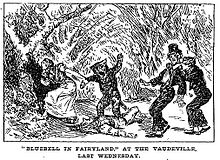Bluebell in Fairyland
| Bluebell in Fairyland | |
|---|---|
 |
|
| Music | Walter Slaughter |
| Lyrics | Aubrey Hopwood and Charles H. Taylor |
| Book | Seymour Hicks |
| Productions | 1901 West End 1905 West End Numerous revivals |
Bluebell in Fairyland is a Christmas-season children's entertainment described as "a musical dream play", in two acts, with a book by Seymour Hicks, lyrics by Aubrey Hopwood (son of John Turner Hopwood) and Charles H. Taylor, and music by Walter Slaughter. It was produced by Charles Frohman. The creators sought to distinguish the work from a Christmas pantomime. The story concerns a flower girl, Bluebell, who on Christmas Eve goes to fairyland in search of the "Sleeping King", seeking to restore him to his throne, which has been usurped by the "Reigning King".
First produced in 1901 in London, Bluebell in Fairyland was a hit, running for 300 performances. The piece provided inspiration for J. M. Barrie's stories of Peter Pan.
Seymour Hicks was a writer-producer-actor in London who, with his singer-actress wife, Ellaline Terriss, created a number of hit musicals and plays in London in the 1890s and for decades thereafter, later turning to film. Other successes in the years after Bluebell were The Cherry Girl (1902), Quality Street (1902), The Earl and the Girl (1903) and The Catch of the Season (1904). They were so successful with these shows that they were able to build two theatres with the profits, the Aldwych Theatre and the Hicks Theatre (now the Gielgud).
Bluebell in Fairyland was first produced at the Vaudeville Theatre in London on 18 December 1901 and played for two performances daily until it closed on 26 June 1902, running for 300 performances. It starred Hicks as Dicky and his wife, Ellaline Terriss, as the title character. Phyllis Dare played Mab. Costumes were by C. Wilhelm. The play was a critical and financial hit; it was revived regularly in London over the next four decades and played in other theatres throughout Britain and elsewhere in the English-speaking world. When Hicks built the Aldwych Theatre, he opened the house in 1905 with a long-running revival of the work.The New York Times called the piece "really a charming and beautiful thing, of a simple, reminiscent kind, with capital music by Walter Slaughter and fine scenery.... Ellaline Terriss acts with exquisite simplicity ... while Hicks himself bears a large share of the work with his accustomed energy and confidence."
...
Wikipedia
